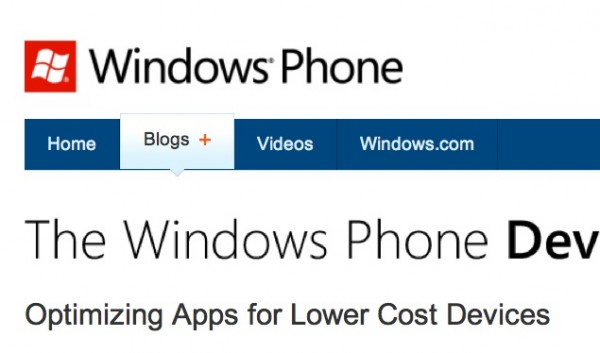Optimising Apps for Tango Limitations
The Windows Phone blog talks about optimising apps for Tango – well not explicitly Tango but for lower cost devices such as the Nokia Lumia 610 and those cheaper handsets that would follow.
I haven’t read the full thing but something I might have read wrong but concerns me is that they mention having home button in app (to make it easier for people to navigate their app quickly) is somehow bad and might end up causing memory leaks. I’m guessing home button is not the Windows button. Anyway, apparently home button navigation can “Â result in circular navigation loops which can fill the back stack with redundant page instances.” I’m no programmer but couldn’t there be a way to just cut the ‘back stack’ the moment a home button is pressed? Essentially when a user presses the home button it’s to exit back to main view anyway (unless accidentally pressed).
The whole of the article focuses mainly on optimisation of applications so that apps can still have a great user experience but not using more resources than necessary. This should, on paper, be beneficial to higher end devices too.
By following these basic principles, you can ensure that your users will have a great experience with your Windows Phone app regardless of the target market. Not only will these optimizations result in great performance on lower cost phones, but the optimizations you make will improve the performance of your app on today’s generation of devices as well, so get a head start tuning your app with the devices you have today. Additionally leverage the 256MB emulator to test your app with the runtime behavior of a 256MB device. Most importantly, have fun building for Windows Phone. We look forward to seeing the great experiences you can bring to the Windows Phone Marketplace.
TheVerge also noted down the new limitations. Cheaper devices, less functionality. We have seen from demoes and the reaction of those that have tried it, that devices like the Lumia 610 still look remarkably snappy.
However, I am not a fan of these limitations listed below.
On the one hand, it might be good for maintaining that snappy fluid user experience but I think it might be detrimental to how WP is perceived. Why can’t they just keep the base from Generation 1 WP7 phones?
Are they working correctly to the needs of their lower-end target consumer? These phones better be damn cheap. The likes of the Lumia 710 is already at £150. Perhaps sub £99? I don’t see why fast app switching had to be removed*. It wasn’t an issue on the core apps as they already resumed in WP Vanilla. Perhaps for larger apps, you might nor even be able to download them anyway. :S.
- Windows Phone Marketplace app restrictions – Some processor-intensive apps have specific memory requirements, and will not work on devices with 256MB of RAM.
- Podcast subscriptions and video podcasts – Devices with 256MB of RAM will not be able to manage podcast subscriptions of watch video podcasts.
- Bing Local Scout – Microsoft is disabling Bing Local Scout on 256MB of RAM devices.
- Fast app switching – The fast application switching, introduced with Mango, will be disabled on 256 MB of RAM devices.
- SkyDrive automatic photo upload – Automatic upload of SkyDrive pictures will not be possible on 256MB of RAM devices, but users can still upload these manually.
- HD video playback – 256MB of RAM devices won’t be able to play video compressed with certain codecs.
- Background agents – Microsoft has removed background agents functionality for devices with 256MB of memory.
Source: Windows Team Blog via TheVerge
Cheers Dan for the tip!
*Engadget says there will be some fast app switching – just as long as it adheres to the new app requirements and not use up more than 90mb ram. Majority of apps are apparently covered by that.
http://www.engadget.com/2012/03/08/microsoft-tango-details/
Cheers stylinred!
Category: Nokia, Windows Phone






Connect
Connect with us on the following social media platforms.